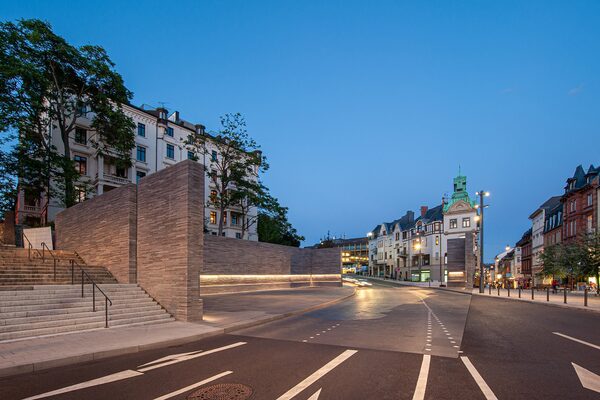Places of remembrance
Since the early 1990s, many places of remembrance have been newly marked in public spaces - including on Michelsberg - and provided with appropriate signs.
Creation of the memorials and places of remembrance
The remembrance of the National Socialist era and the commemoration of the victims of Nazi crimes in the form of memorials, places of remembrance and days of remembrance began in the 1980s. In Wiesbaden, as in many German cities, it was initially civil society groups that initiated various forms of commemoration. The state capital of Wiesbaden took up the initiatives from the citizenry and established them with the creation of memorials and places of remembrance. The memorials and places of remembrance are marked by information boards, as the state capital of Wiesbaden commemorates in a decentralized manner at authentic locations spread across almost the entire city. Memorials have been erected at the former site of the synagogue destroyed in the November pogroms of 1938 and the former cattle loading ramp behind Wiesbaden's main railway station, from where Jews, Sintizze and Sinti were deported to concentration and extermination camps. Victims of medical crimes and from the concentration camps are commemorated with an ensemble at the South Cemetery. In section U 11 there is an urn burial ground where the remains of 171 murdered people were interred.
The state capital of Wiesbaden also commemorates the victims of the Nazi regime on the national days of remembrance. Every year, central commemorative events are held around January 27 and November 9. On the "Day of Remembrance of the Victims of National Socialism" on January 27, the Cultural Office coordinates a series of events every year. On November 9, the Jewish Community of Wiesbaden, the Society for Christian-Jewish Cooperation and the City of Wiesbaden commemorate the pogroms against the Jewish population. In addition, memorial events on March 8 and September 1 commemorate the large-scale deportations. On March 8, 1943, the Wiesbaden Sintizze and Sinti were deported to Auschwitz via the cattle loading ramp of the slaughterhouse. Most of the Wiesbaden Jews had already been deported from here to the concentration and extermination camps on May 23, June 10 and September 1, 1942.
Contact us
City archive
Address
65197 Wiesbaden
Postal address
65029 Wiesbaden
Arrival
Notes on public transport
Public transportation: Bus stop Kleinfeldchen/Stadtarchiv, bus lines 4, 17, 23, 24 and 27 and bus stop Künstlerviertel/Stadtarchiv, bus line 18.
Telephone
- +49 611 313022
- +49 611 313977
Opening hours
Opening hours of the reading room:
- Monday: 9 a.m. to 12 p.m.
- Tuesday: 9 am to 4 pm
- Wednesday: 9 am to 6 pm
- Thursday: 12 to 16 o'clock
- Friday: closed
